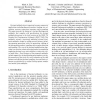52 search results - page 3 / 11 » The New IEEE-754 Standard for Floating Point Arithmetic |
ARITH
1999
IEEE
13 years 10 months ago
1999
IEEE
The design and implementation of a double precision floating-point IEEE-754 standard adder is described which uses "flagged prefix addition" to merge rounding with the s...
ARITH
2007
IEEE
14 years 3 days ago
2007
IEEE
Decimal multiplication is important in many commercial applications including financial analysis, banking, tax calculation, currency conversion, insurance, and accounting. This p...
CIT
2006
Springer
13 years 9 months ago
2006
Springer
IEEE 754r is the ongoing revision to the IEEE 754 floating point standard. A major enhancement to the standard is the addition of decimal format, thus the design of BCD arithmetic...
ERSA
2004
13 years 7 months ago
2004
Abstract-- Technological advances have made FPGAs an attractive platform for the acceleration of complex scientific applications. These applications demand high performance and hig...
ARITH
2003
IEEE
13 years 11 months ago
2003
IEEE
Decimal arithmetic is the norm in human calculations, and human-centric applications must use a decimal floating-point arithmetic to achieve the same results. Initial benchmarks i...


